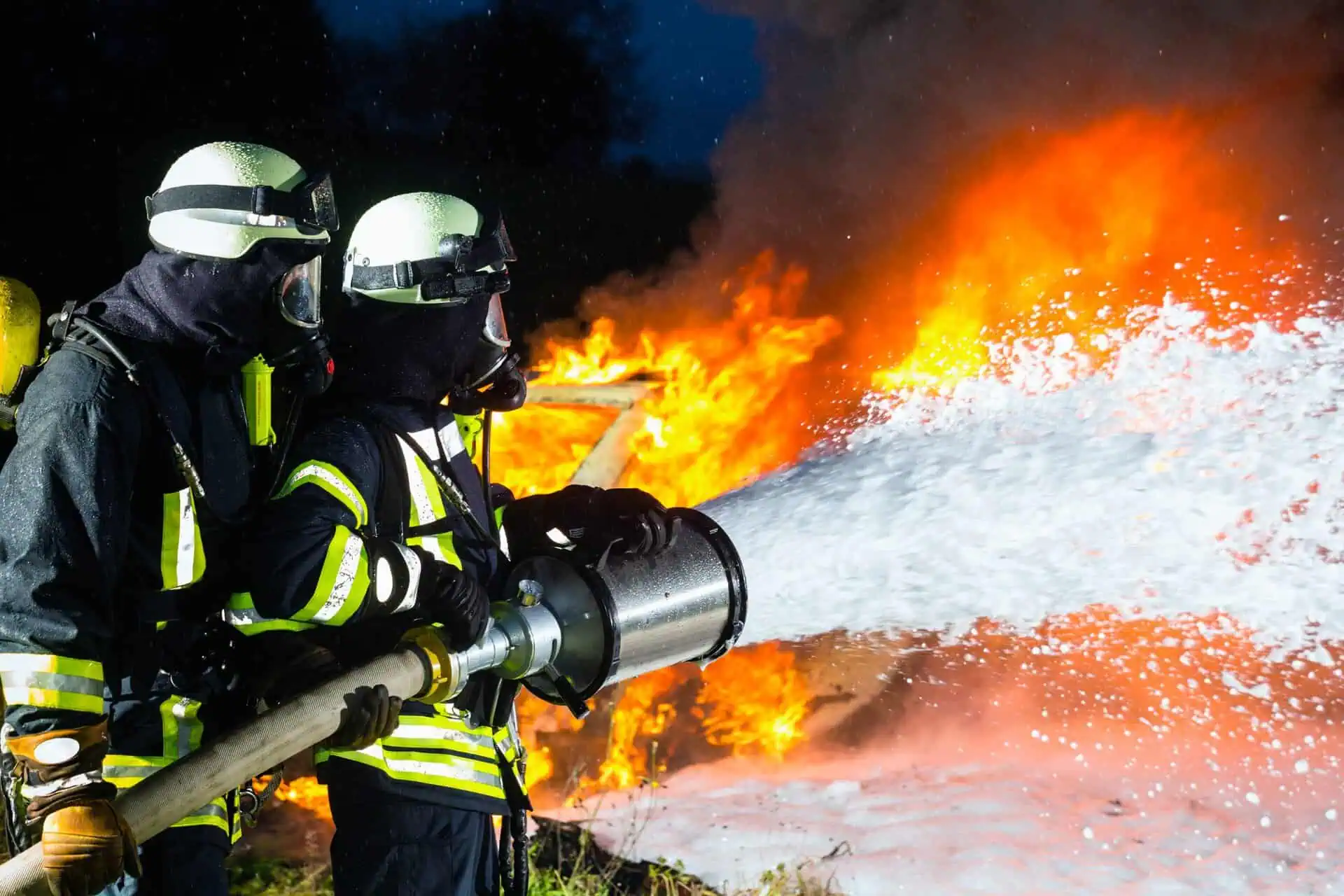AFFF Lawsuit Settlement Amounts & Payouts
- Last Updated: June 30th, 2025

Attorney Jessica Paluch-Hoerman, founder of TruLaw, has over 28 years of experience as a personal injury and mass tort attorney, and previously worked as an international tax attorney at Deloitte. Jessie collaborates with attorneys nationwide — enabling her to share reliable, up-to-date legal information with our readers.
Legally Reviewed
This article has been written and reviewed for legal accuracy and clarity by the team of writers and legal experts at TruLaw and is as accurate as possible. This content should not be taken as legal advice from an attorney. If you would like to learn more about our owner and experienced injury lawyer, Jessie Paluch, you can do so here.
Fact-Checked
TruLaw does everything possible to make sure the information in this article is up to date and accurate. If you need specific legal advice about your case, contact us by using the chat on the bottom of this page. This article should not be taken as advice from an attorney.
Key takeaways:
- AFFF lawsuit settlement amounts are projected to range from $20,000 to $600,000 (or more) based on attorney projections, with kidney or testicular cancer cases potentially receiving the highest compensation due to strong scientific evidence linking PFAS exposure to these specific cancers.
- Military personnel, firefighters, and civilians exposed to PFAS-contaminated water who subsequently developed cancer including kidney, testicular, liver, thyroid, or pancreatic cancer may be eligible for financial compensation from manufacturers like 3M and DuPont.
- Legal experts predict AFFF personal injury settlements will conclude by the end of 2025, making it important for eligible plaintiffs to file their claims immediately before global settlement registration deadlines permanently exclude new participants from compensation opportunities.
What are the Average AFFF Lawsuit Settlement Amounts?
Question: What are the average AFFF lawsuit settlement amounts?
Answer: The average AFFF settlement amounts are projected to range from $20,000 to $600,000 (or more) based on early case valuations and attorney projections, though actual amounts will vary dramatically based on cancer type, exposure duration, and individual circumstances.
Settlement tiers will likely reflect cancer severity, with kidney and testicular cancer cases potentially commanding higher values due to strong scientific causation evidence from National Cancer Institute studies.
TruLaw is actively assisting individuals with AFFF cancer lawsuits across all fifty (50) states in the United States.
On this page, we’ll discuss this question in further depth, major defendants in AFFF litigation, factors affecting settlement values, and much more.
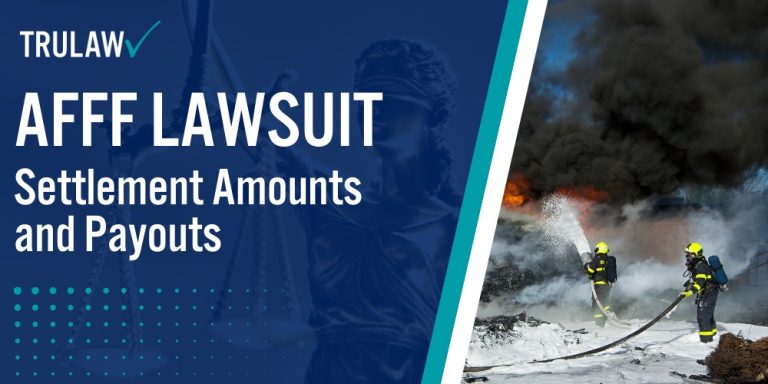
Factors Determining AFFF Settlement Values
Cancer type and stage at diagnosis heavily influence settlements, with primary cancers like kidney and testicular cancer receiving maximum compensation due to robust National Cancer Institute research linking PFAS exposure to these specific malignancies.
Duration and intensity of AFFF foam exposure create higher settlement values for career firefighters and military personnel with decades of documented foam use during training exercises and emergency responses at contaminated installations.
Age at diagnosis impacts economic damages as younger plaintiffs face longer treatment periods, greater lost earnings potential, and extended impacts on quality of life compared to older victims with shorter life expectancies.
TruLaw is currently accepting clients for the AFFF Lawsuit, seeking compensation for medical expenses, lost wages, pain and suffering, and other damages related to PFAS exposure and the resulting health conditions.
If you or someone you love has been diagnosed with cancer after AFFF exposure, you may be eligible to seek compensation.
Contact TruLaw using the chat on this page to receive an instant case evaluation that can help you determine if you qualify to file an AFFF Lawsuit today.
Table of Contents
What Is AFFF and Why Are These Chemicals Dangerous?
Aqueous Film-Forming Foam (AFFF) has served as the primary firefighting agent for suppressing fuel-based fires at military installations and civilian airports since the 1970s.
These specialized foam concentrates contain per- and polyfluoroalkyl substances (PFAS) – synthetic chemicals that earned the nickname “forever chemicals” due to their inability to break down naturally in human bodies or the environment.
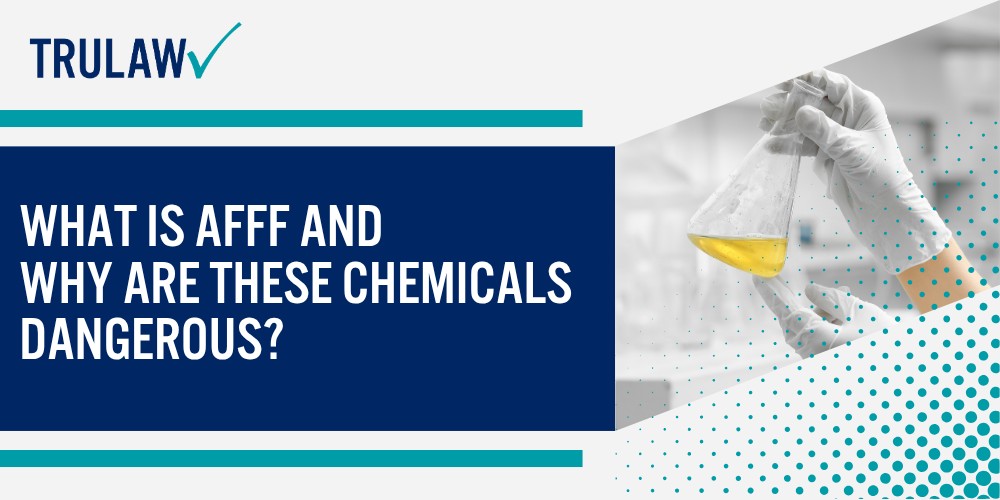
The mounting scientific evidence linking PFAS exposure to various cancers and serious health issues has prompted over 10,000 personal injury lawsuits as of June 2025, with legal experts predicting settlements potentially reaching billions of dollars.
The Science Behind PFAS “Forever Chemicals” in Firefighting Foam
Perfluoroalkyl and polyfluoroalkyl substances (PFAS) represent a class of over 4,700 toxic chemicals, with perfluorooctanoic acid (PFOA) and perfluorooctane sulfonate (PFOS) being the most prevalent compounds found in AFFF formulations.
These engineered molecules feature carbon-fluorine bonds that rank among the strongest chemical bonds in nature, making them virtually indestructible under normal environmental conditions.
PFAS chemicals demonstrate these concerning characteristics:
- Bioaccumulation: PFAS compounds accumulate in human blood, liver, and kidney tissues over time rather than being metabolized or eliminated
- Extended half-life: PFOA has a half-life of 2.3 years in human blood, while PFOS persists for 5.4 years before concentrations reduce by half
- Environmental persistence: These chemicals resist degradation from heat, water, oil, and microbial breakdown processes
- Widespread distribution: Once released, PFAS migrate through soil and groundwater systems, contaminating drinking water supplies miles from original sources
PFAS enters the human body through multiple exposure pathways during firefighting operations, including direct skin absorption through protective gear, inhalation of foam particles during application and training exercises, and consumption of contaminated drinking water from sources near training facilities or emergency response sites.
Decades of Corporate Knowledge and Cover-Ups
Internal company documents revealed through litigation discovery demonstrate that major PFAS manufacturers 3M and DuPont possessed evidence of these chemicals’ toxicity decades before public disclosure.
As early as the 1950s, 3M conducted animal studies that consistently showed PFAS toxicity, with laboratory tests in 1976 killing seven out of ten rats within two weeks of exposure.
DuPont’s internal research throughout the 1970s and 1980s documented similar concerning findings, including liver damage and reproductive effects in animal studies.
Key milestones in the corporate concealment timeline span several decades:
- 1950s: 3M begins internal toxicity studies showing consistent harmful effects in animal testing
- 1961: 3M discovers PFAS chemicals do not degrade in the environment
- 1970s: 3M identifies widespread PFAS presence in human blood samples from the general U.S. population
- 1991: When independent researchers detected PFAS in groundwater, companies issued joint statements claiming “no known toxic or ill health effects in humans”
The scope of this decades-long concealment became apparent through whistleblower testimony and document discovery in current firefighting foam cancer lawsuits, exposing how manufacturers actively suppressed evidence of PFAS hazards while continuing to market these products as safe to military personnel, firefighters, and regulatory agencies.
Primary Uses and Exposure Sources for AFFF
Military installations represent the largest source of AFFF usage and subsequent PFAS contamination, with the Department of Defense identifying over 700 bases with known or suspected PFAS releases from firefighting foam.
These bases utilized AFFF extensively for aircraft crash rescue training, hangar fire suppression systems, and emergency response protocols spanning multiple decades of military operations.
Major exposure sources feature the following locations:
- Military installations: Air Force bases, Navy facilities, Army installations, and National Guard training sites across all 50 states
- Civilian airports: Commercial aviation facilities using AFFF for aircraft rescue and firefighting operations
- Industrial facilities: Chemical plants, oil refineries, and manufacturing sites employing AFFF fire suppression systems
- Firefighter training academies: Municipal and industrial training centers conducting live-fire exercises with AFFF
- Surrounding communities: Residential areas near contaminated sites affected by groundwater migration
Environmental contamination occurs through multiple pathways, with training exercises representing the most substantial source of PFAS releases.
Repeated foam applications during firefighter training created concentrated contamination zones that migrated through soil and groundwater systems, ultimately affecting private wells and municipal water supplies serving millions of Americans exposed to firefighting foam across contaminated regions.
If you or a loved one served at a military installation or worked as a firefighter and developed cancer or other serious health conditions, you may be eligible to seek compensation.
Contact TruLaw using the chat on this page to receive an instant case evaluation and determine whether you qualify to join others in filing an AFFF lawsuit today.
Cancers and Health Conditions Linked to AFFF Exposure
Scientific research published by the National Cancer Institute and Environmental Protection Agency has established clear causation links between AFFF chemical exposure from firefighting foam and multiple cancer types.
Recent studies involving U.S. Air Force servicemen and firefighter health data show elevated risks for specific cancers, with some conditions demonstrating stronger epidemiological evidence than others.
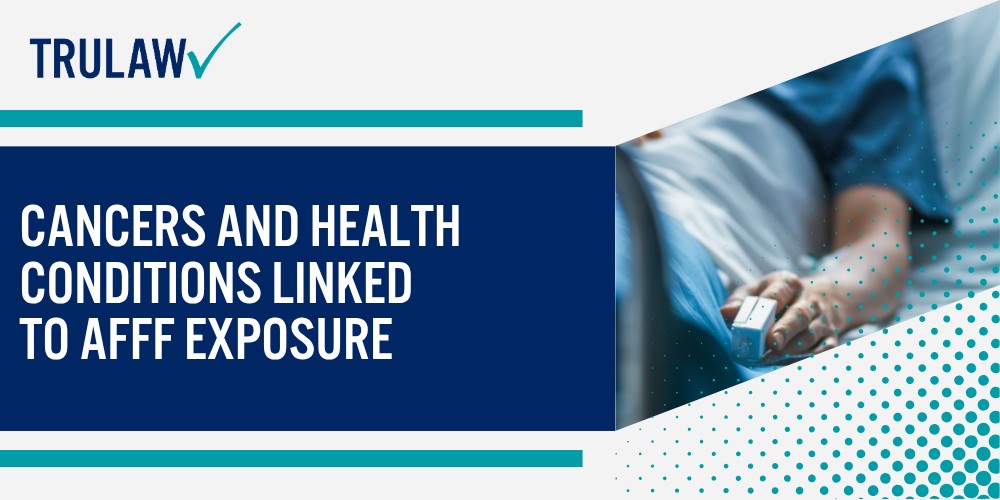
These varying levels of scientific support will determine placement in the anticipated settlement tier system, with primary cancers likely qualifying for higher compensation ranges based on established causation strength.
Primary Cancers With Strongest Scientific Links
The National Cancer Institute’s comprehensive research on Air Force personnel exposed to AFFF has identified kidney cancer and testicular cancer as having the most robust scientific evidence for PFAS causation.
A groundbreaking 2023 study published in Environmental Health Perspectives found that elevated blood levels of perfluorooctanesulfonic acid (PFOS) were directly associated with increased testicular cancer risk among servicemen who worked as firefighters at military installations.
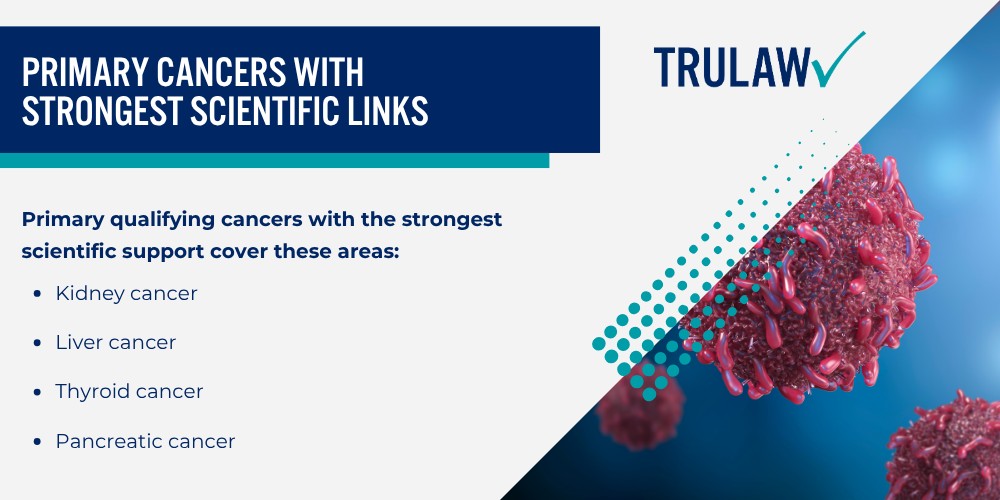
Primary qualifying cancers with the strongest scientific support cover these areas:
- Kidney cancer: Multiple epidemiological studies show consistently elevated rates among firefighters with documented AFFF exposure
- Testicular cancer: Air Force study demonstrates clear PFOS blood level correlations with cancer development in young servicemen
- Liver cancer: Ongoing bellwether trials specifically address hepatic cancers linked to PFAS bioaccumulation in liver tissue
- Thyroid cancer: 2023 research published in eBioMedicine reports strong associations between PFAS exposure and papillary thyroid cancer rates
- Pancreatic cancer: Emerging evidence suggests PFAS disruption of pancreatic function contributes to malignant transformation
The biological mechanisms underlying these cancer connections involve PFAS accumulation in specific organ systems over time.
These synthetic chemicals disrupt normal cellular processes, interfere with hormone regulation, and create chronic inflammatory conditions that promote malignant cell growth, particularly in kidney and testicular tissues where PFAS concentrations reach highest levels.
Secondary Cancers and Qualifying Conditions
Beyond the primary cancer types, additional health issues linked to prolonged AFFF exposure may qualify for compensation despite facing greater causation challenges due to multiple contributing risk factors.
Recent firefighter health studies indicate elevated rates of prostate cancer, bladder cancer, and certain blood cancers among personnel with documented histories of AFFF firefighting foam exposure.
Secondary cancers and conditions that may qualify extend to the following areas:
- Prostate cancer: Studies show firefighters face twice the risk of prostate cancer death compared to general population
- Bladder cancer: Canadian research indicates firefighters have twice the likelihood of bladder cancer mortality
- Breast cancer: Limited evidence suggests potential links, particularly in cases with extensive occupational exposure
- Ulcerative colitis: National Academy of Sciences guidelines recommend clinical follow-up for this inflammatory condition
- Thyroid disease: Non-cancerous thyroid dysfunction linked to PFAS disruption of endocrine function
- Liver damage: Elevated liver enzymes and fatty liver disease are associated with PFAS bioaccumulation
These secondary conditions will likely fall into lower settlement tiers but remain eligible for meaningful compensation based on individual exposure documentation and medical evidence.
Cases involving multiple conditions or particularly severe manifestations may receive tier upgrades depending on the final settlement matrix structure.
Medical Evidence Requirements for Your Claim
Successful AFFF claims require comprehensive medical documentation establishing both the qualifying diagnosis and timeline correlation with documented exposure periods.
Pathology reports confirming specific cancer types, complete treatment histories, and expert medical testimony linking PFAS exposure to individual health outcomes form the foundation of claim valuation.
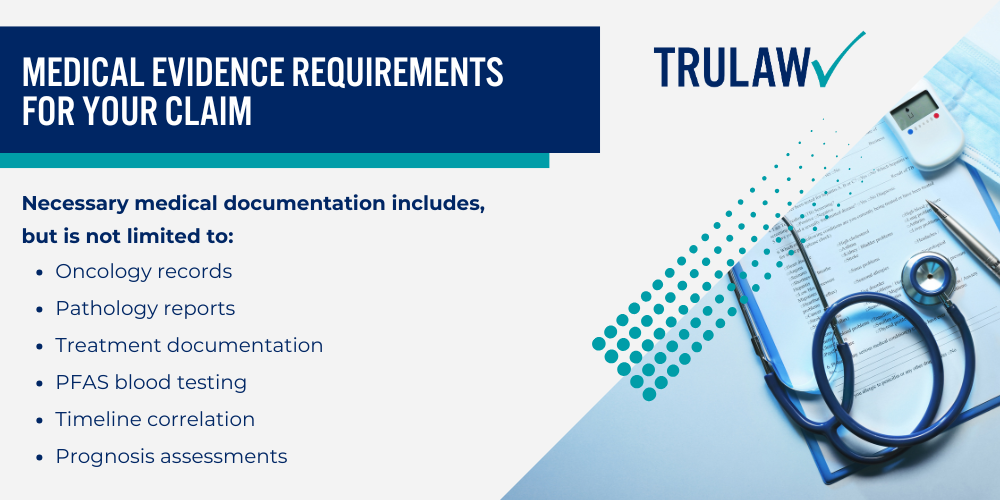
Necessary medical documentation includes, but is not limited to:
- Oncology records: Complete cancer diagnosis reports, staging information, and treatment protocols
- Pathology reports: Tissue biopsy results confirming specific cancer types and cellular characteristics
- Treatment documentation: Surgical reports, chemotherapy records, radiation therapy summaries, and ongoing care plans
- PFAS blood testing: Serum concentration measurements demonstrating elevated levels when available
- Timeline correlation: Medical records establishing diagnosis dates relative to known exposure periods
- Prognosis assessments: Medical opinions regarding long-term health impacts and life expectancy effects
The role of expert medical testimony becomes important in validating PFAS-cancer connections, particularly for cases involving pre-existing medical conditions or family history of cancer.
Experienced AFFF attorneys work with leading oncologists and toxicologists to strengthen individual claims by demonstrating how PFAS exposure contributed to cancer development beyond other risk factors.
If you or a loved one have been diagnosed with cancer or health conditions and have a history of military service or firefighting work involving AFFF exposure, you may be eligible to seek compensation.
Contact TruLaw using the chat on this page to receive an instant case evaluation and determine whether you qualify to join others in filing an AFFF lawsuit today.
Settlement Tier System and Projected Payout Ranges
Legal experts analyzing the AFFF firefighting foam litigation predict settlement amounts will follow a structured tier system similar to other successful mass tort cases, with individual payouts ranging from $20,000 for lower-tier claims to over $600,000 for the most severe cases.
Attorney projections suggest average AFFF lawsuit payouts will fall between $250,000 and $450,000, based on precedent from the recent $10.3 billion 3M water contamination settlement and similar PFAS litigation outcomes.
Individual case placement within this tier system will depend on a points-based scoring matrix evaluating cancer severity, exposure duration, age at diagnosis, and strength of causation evidence.
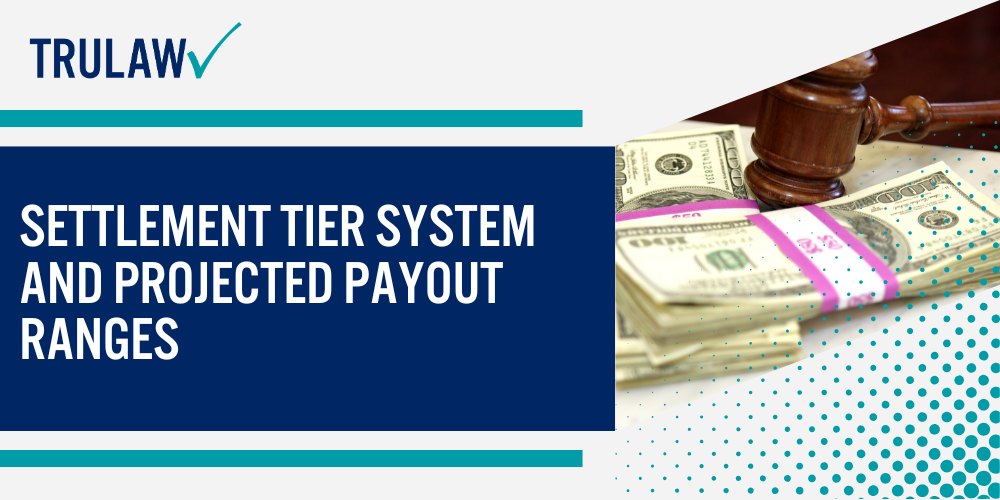
Please be advised that any projected or estimated settlement amounts mentioned on this page are general estimations and are not guaranteed.
These figures are based on similar previous litigations, the nature of injuries sustained, and estimated costs of damages.
They are meant to provide a general idea of what settlement ranges could look like and should not be taken as definitive expectations for your case.
Contact TruLaw using the chat on this page to receive an instant case evaluation.
Top Tier Cases – Highest Settlement Values ($300,000 to $600,000+)
The highest settlement tier will include plaintiffs with the most compelling combination of severe cancer diagnoses, extensive occupational exposure, and minimal confounding risk factors.
These cases typically involve career military personnel or firefighters with decades of direct AFFF contact who developed aggressive primary cancers at relatively young ages, creating clear causation links and substantial economic damages.
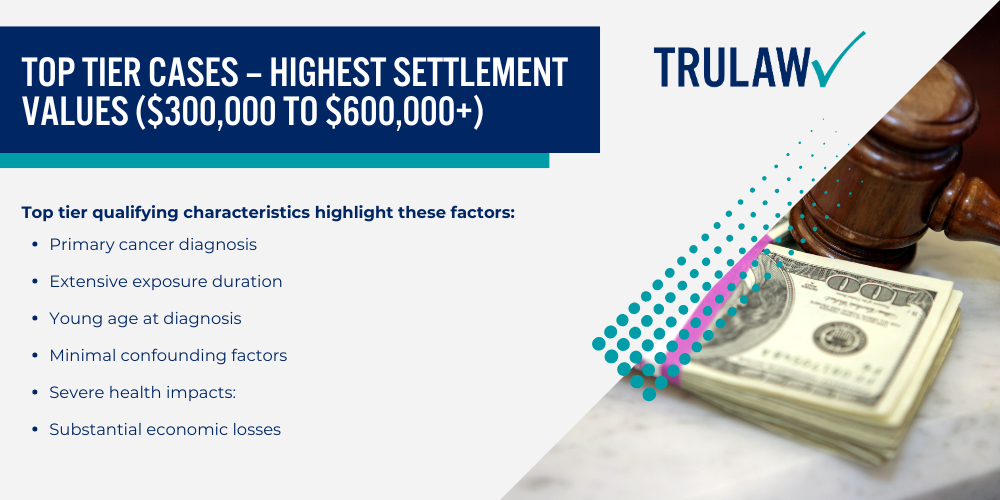
Top tier qualifying characteristics highlight these factors:
- Primary cancer diagnosis: Kidney, testicular, liver, thyroid, or pancreatic cancers with strongest scientific causation evidence
- Extensive exposure duration: 15+ years of military service or firefighting career with documented AFFF contact
- Young age at diagnosis: Cancer development before age 50, indicating accelerated disease progression
- Minimal confounding factors: Non-smokers without family cancer history or other chemical exposures
- Severe health impacts: Advanced cancer stages requiring extensive medical treatment with poor prognosis
- Substantial economic losses: High medical costs, lost earnings, and reduced life expectancy
Cases involving multiple qualifying cancers or particularly rare malignancies in young servicemen may receive enhanced point allocations, potentially pushing settlement values above $600,000 depending on the final matrix structure and available settlement funds.
Middle and Lower Tier Settlements ($20,000 to $300,000)
Middle tier cases typically involve moderate exposure duration of 5-15 years combined with secondary cancer types or non-cancer conditions that carry good recovery prognoses.
These settlements recognize substantial PFAS-related health impacts while accounting for additional risk factors that may complicate pure causation arguments.
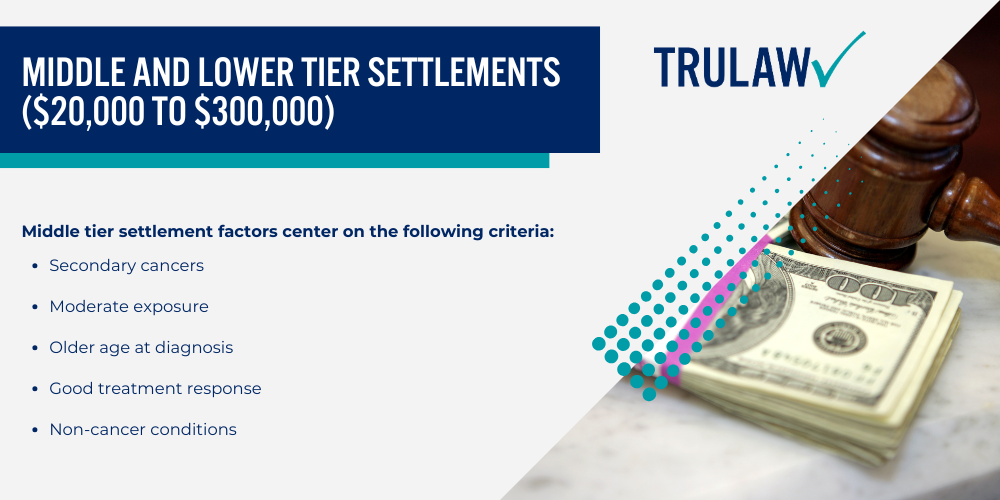
Middle tier settlement factors center on the following criteria:
- Secondary cancers: Prostate, bladder, or breast cancers with multiple potential causation sources
- Moderate exposure: 5-15 years of military service or firefighting with AFFF contact
- Older age at diagnosis: Cancer development after age 60 when baseline cancer risks increase
- Good treatment response: Early-stage cancers with successful treatment and positive prognosis
- Non-cancer conditions: Thyroid disease, ulcerative colitis, or liver damage requiring ongoing medical care
Lower tier qualifications include minimal exposure cases involving shorter service periods, residential exposure from contaminated water supplies, or cases with considerable confounding factors such as extensive smoking history, genetic predisposition, or exposure to other carcinogenic substances that weaken PFAS causation arguments.
Factors That Strengthen or Weaken Your Settlement Value
Settlement calculations will incorporate numerous variables beyond basic cancer type and exposure duration, with documentation quality and expert medical testimony playing decisive roles in final point tallies.
Geographic location, state laws regarding damages, and individual economic circumstances also influence settlement values within established tier ranges.

Factors that strengthen settlement value emphasize these elements:
- Military service documentation: DD-214 forms, training records, and incident reports proving direct AFFF exposure
- Multiple health conditions: Presence of both cancer and non-cancer PFAS-related conditions
- High PFAS blood levels: Laboratory tests demonstrating elevated serum concentrations
- Proximity to contaminated sites: Residence or service near EPA-confirmed PFAS contamination zones
- Strong expert testimony: Medical opinions directly linking PFAS exposure to individual cancer development
- Economic documentation: Detailed records of medical expenses, lost wages, and future care needs
Conversely, factors that may weaken settlement positions include substantial smoking history, genetic cancer syndromes, exposure to other known carcinogens, minimal documentation of AFFF contact, older age at diagnosis when cancer risks naturally increase, and conflicting medical opinions regarding causation strength.
If you or a loved one have strong cases involving primary cancer diagnoses and extensive military or firefighting careers, you may be eligible to seek compensation.
Contact TruLaw using the chat on this page to receive an instant case evaluation and determine whether you qualify for top-tier settlement consideration in an AFFF lawsuit today.
Current Status of AFFF Litigation and Timeline
The AFFF firefighting foam MDL (MDL 2873) has gained substantial momentum throughout 2025, with case filings increasing from 8,430 in March to 8,928 by April, reflecting attorney confidence in imminent settlement prospects.
The recent completion of billions in water contamination settlements by 3M ($10.3 billion) and DuPont ($1.19 billion) has removed major obstacles to personal injury resolution, creating unprecedented pressure on defendants to negotiate global settlement terms.
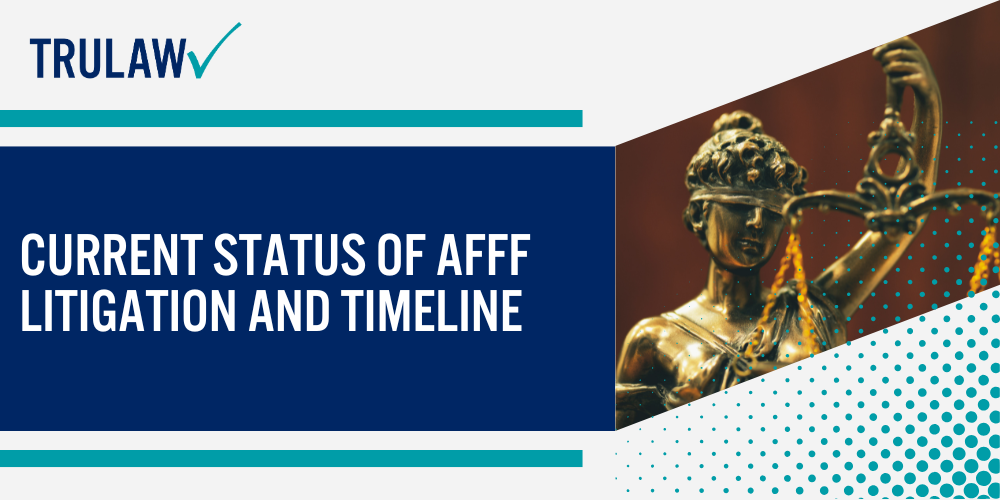
Legal experts predict personal injury settlements will conclude by end of 2025, particularly with the October 6, 2025 bellwether trial date approaching and Science Day presentations scheduled for June 20, 2025.
MDL Case Numbers and Bellwether Trial Schedule
As of June 2025, AFFF MDL (MDL 2873) contains over 8,900 active personal injury cases consolidated in the U.S. District Court for the District of South Carolina, with an additional 400+ new lawsuits filed in the past month alone.
This surge in AFFF firefighting foam cases indicates growing awareness among military veterans and firefighters connecting their cancer diagnoses to AFFF exposure during their service careers.
Key milestones and trial dates in the AFFF multidistrict litigation outline these considerations:
- June 20, 2025: Science Day presentations in Charleston, South Carolina, focusing on PFAS health effects and causation evidence
- October 6, 2025: First Tier 2 bellwether trial scheduled for kidney cancer and testicular cancer claims
- January 2025: Court selection of Group A cases for trial preparation and discovery completion
Bellwether trials serve as important pressure points in mass tort litigation by establishing jury verdict ranges that inform settlement negotiations.
The scheduled October trial will test key causation arguments and damages theories, providing both sides with valuable data about potential trial outcomes across thousands of similar cases.
Settlement Predictions and Key Dates for 2025
Attorney predictions for global AFFF settlement by end of 2025 are based on multiple converging factors, including completed water contamination settlements totaling over $11 billion, approaching bellwether trial dates, and corporate earnings pressures from ongoing litigation costs.
The successful resolution of municipal water claims demonstrates defendant willingness to pay substantial settlements rather than face unpredictable jury verdicts.
Important pressure points driving 2025 settlement timing detail the following aspects:
- Bellwether trial proximity: October 2025 trial date creates urgency for settlement negotiations
- Water settlement precedent: Billion-dollar resolutions establish PFAS liability acceptance by major defendants
- Corporate earnings impact: Ongoing litigation costs and accrual requirements affecting quarterly financial reports
- Regulatory momentum: EPA drinking water standards and PFAS discharge limits increasing compliance costs
- Scientific consensus: Growing peer-reviewed evidence strengthening plaintiff causation arguments
- Public awareness: Media coverage and veteran outreach campaigns driving new case filings
The acceleration in new case filings to nearly 500 per month indicates attorney confidence that settlement resolution is imminent, as law firms typically increase marketing efforts and case intake when they anticipate favorable settlement terms within 12-18 months.
Why Filing Before Settlement Matters
Once global settlement terms are announced, strict registration deadlines will likely exclude late filers from compensation opportunities, regardless of case strength or exposure severity.
Historical mass tort settlements typically include cutoff dates for claim submissions, after which even qualifying plaintiffs cannot participate in settlement distributions.
Important timing considerations specify these requirements:
- Registration deadlines: Settlement agreements typically require claim submission within 90-180 days of announcement
- Statute of limitations: State-specific deadlines of 2-6 years from diagnosis may permanently bar claims
- Documentation preservation: Medical records, military files, and witness testimony become harder to obtain over time
- Settlement tier placement: Early filers often receive better documentation assistance and expert testimony support
- Negotiating leverage: Cases filed before settlement announcement may qualify for enhanced consideration
- Administrative efficiency: Settlement administrators prioritize claims with complete documentation packages
Veterans and firefighters who delay filing risk complete exclusion from what may be the only opportunity for AFFF-related compensation.
Unlike individual lawsuits that can be filed indefinitely within statute of limitations periods, mass tort settlements create finite windows for participation that close permanently once deadlines pass.
If you or a loved one are eligible plaintiffs who need to preserve their rights before settlement negotiations conclude, you may be eligible to seek compensation.
Contact TruLaw using the chat on this page to receive an instant case evaluation and ensure your AFFF lawsuit is filed before settlement negotiations exclude new participants from compensation opportunities.
Who Qualifies for AFFF Lawsuit Compensation
Eligibility for AFFF lawsuit compensation extends beyond active military personnel and career firefighters to include various civilian exposure scenarios involving contaminated water supplies and occupational contact with firefighting foam.
The consolidated AFFF multidistrict litigation (sometimes incorrectly referred to as the AFFF class action lawsuit) currently represents plaintiffs from all 50 states, demonstrating the broad geographical scope of PFAS contamination from military installations, airports, and industrial facilities.
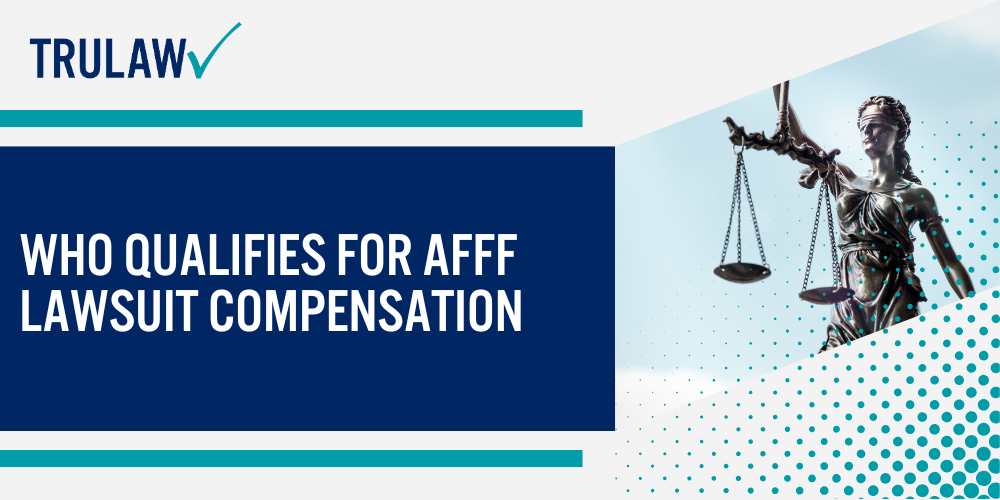
Courts have recognized both occupational exposure through direct AFFF contact and environmental exposure through contaminated drinking water as valid pathways for establishing legal standing in personal injury claims.
Military Personnel and Firefighter Claims
Military service members, veterans, and their families who lived on or worked at installations using AFFF for aircraft firefighting and training exercises represent the largest category of eligible plaintiffs.
The Department of Defense has identified over 700 military installations with known or suspected PFAS contamination from decades of firefighting foam usage, creating potential claims for millions of current and former service members.
Military personnel eligibility criteria present these key factors:
- Active duty service members: Current military personnel stationed at bases with documented AFFF usage or contamination
- Veterans: Former service members with DD-214 documentation proving service at affected installations
- National Guard and Reserve: Personnel who trained or served at contaminated military facilities
- Military firefighters: Specialized personnel with direct AFFF exposure during aircraft rescue and firefighting operations
- Base personnel: Service members working near hangars, fuel storage areas, or firefighting training facilities
- Family members: Military dependents who lived on contaminated installations and developed qualifying health conditions
Documentation requirements for military claims center on establishing service connection through DD-214 forms, unit assignments, and training records that prove presence at affected installations during periods of AFFF usage.
The VA has recognized PFAS exposure as a potential service-connected condition, though individual claims still require medical evidence linking specific health conditions to documented exposure periods.
Civilian and Community Exposure Claims
Civilian exposure claims encompass individuals who encountered PFAS through occupational duties at airports, chemical facilities, or firefighting academies, as well as residents whose drinking water became contaminated through environmental migration from nearby AFFF usage sites.
These claims often involve longer exposure periods through contaminated water consumption rather than direct foam contact.
Civilian exposure eligibility includes, but is not limited to:
- Airport employees: Personnel working at commercial aviation facilities using AFFF fire suppression systems
- Municipal firefighters: Civilian firefighting personnel using AFFF during training exercises and emergency responses
- Chemical plant workers: Employees at facilities manufacturing or using PFAS-containing firefighting foam
- Private well users: Residents whose water sources became contaminated through groundwater migration from military bases
- Municipal water customers: Community members served by water systems affected by nearby AFFF contamination
- Secondary exposure victims: Family members of firefighters or military personnel who encountered PFAS through contaminated clothing or equipment
Geographic proximity to contaminated sites becomes important for civilian claims, with successful cases typically involving residence or employment within defined contamination zones identified through EPA testing and water quality assessments conducted near military installations and airports.
Evidence and Documentation Requirements
Successful AFFF claims require comprehensive documentation establishing both qualifying exposure and related health conditions. Evidence quality substantially impacts settlement tier placement and compensation amounts, including emotional distress and health problems.
Experienced AFFF attorneys often assist clients in obtaining missing records through military archives, medical facilities, and environmental testing databases maintained by regulatory agencies.
Required documentation packages establish these parameters:
- Military service records: DD-214 forms, unit assignments, training logs, and incident reports proving base assignments during contamination periods
- Employment documentation: Personnel files, training records, and work histories demonstrating firefighting duties or AFFF exposure
- Medical records: Complete diagnosis documentation, pathology reports, treatment histories, and oncology records for qualifying conditions
- Water testing results: Laboratory analyses showing PFAS contamination levels in private wells or municipal water supplies
- PFAS blood testing: Serum concentration measurements demonstrating elevated levels when available through VA or private testing
- Property records: Deeds, tax records, and utility bills proving residence in contaminated areas during exposure periods
- Witness statements: Affidavits from colleagues, family members, or fellow service members who can verify exposure circumstances
Attorneys specializing in AFFF litigation maintain relationships with military record archives, environmental testing laboratories, and medical experts who can help strengthen individual claims by filling documentation gaps and providing expert testimony linking exposure to specific health outcomes.
If you or a loved one are military veterans and firefighters who believe they qualify for AFFF compensation, you may be eligible to seek compensation.
Contact TruLaw using the chat on this page to receive an instant case evaluation and determine whether your military service, firefighting career, or residential exposure qualifies for an AFFF lawsuit claim before settlement registration deadlines expire.
Major Defendants and Corporate Liability
The AFFF litigation targets multiple chemical manufacturers and foam distributors who produced, marketed, and sold PFAS-containing firefighting foam to military and civilian markets for over five decades.
Primary firefighting foam manufacturers include industry giants 3M Company, DuPont and its spin-offs Chemours and Corteva, along with firefighting equipment manufacturers like Tyco Fire Products and Kidde-Fenwal.
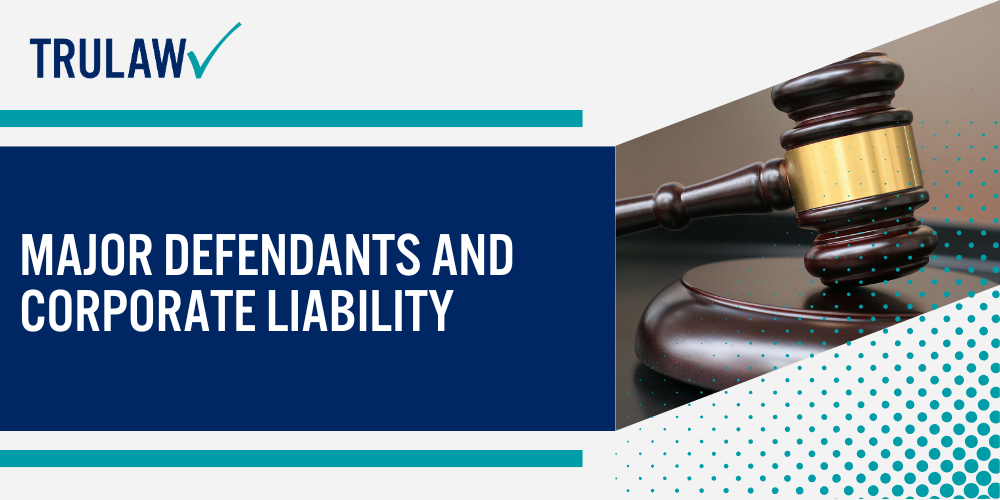
The recent completion of over $12 billion in water contamination settlements by these defendants demonstrates their acceptance of liability for PFAS-related damages, setting important precedent for personal injury claim resolution and establishing substantial recovery sources for affected plaintiffs.
Primary AFFF Firefighting Foam Manufacturers Facing Lawsuits
3M Company stands as the largest defendant in AFFF litigation, having developed PFAS chemistry in the 1940s and maintained dominant market share in firefighting foam production for military contracts spanning multiple decades.
The company’s recent $10.3 billion settlement with public water suppliers represents the largest environmental settlement in corporate history, reflecting both the scope of contamination and defendant acceptance of PFAS liability.
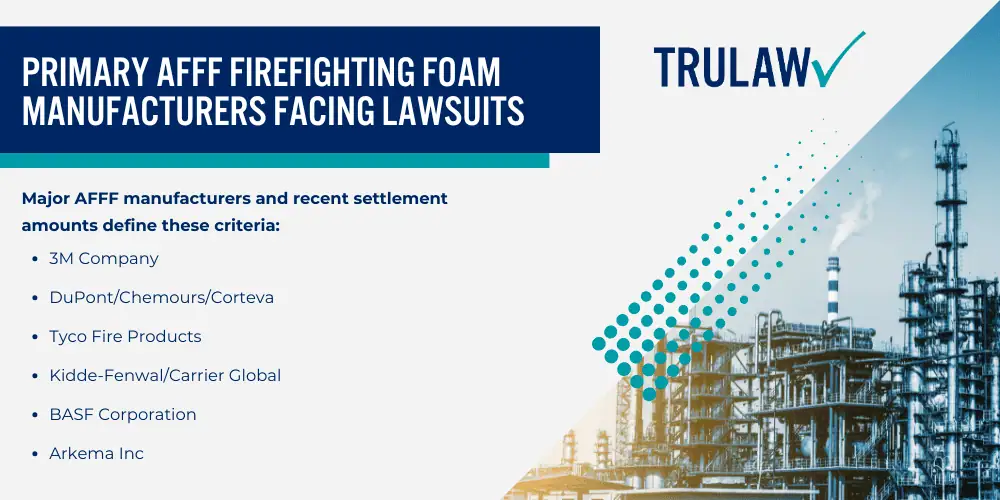
Major AFFF manufacturers and recent settlement amounts define these criteria:
- 3M Company: $10.3 billion water contamination settlement establishing primary liability for PFAS manufacturing and distribution
- DuPont/Chemours/Corteva: $1.19 billion combined settlement representing successor liability for DuPont’s PFAS operations
- Tyco Fire Products: $750 million settlement with water suppliers for foam manufacturing and distribution operations
- Kidde-Fenwal/Carrier Global: $730 million settlement agreement addressing firefighting equipment manufacturing liability
- BASF Corporation: Active defendant with substantial PFAS manufacturing operations and military supply contracts
- Arkema Inc.: Chemical manufacturer facing liability for PFAS production and AFFF formulation development
Corporate spin-offs and mergers have created intricate liability chains requiring attorneys to trace ownership histories and successor obligations to identify recovery sources.
DuPont’s 2017 corporate restructuring created separate entities Chemours and Corteva to isolate PFAS liabilities, though courts have maintained parent company responsibility for historical contamination.
Evidence of Corporate Negligence and Liability
Discovery proceedings have revealed extensive internal documentation demonstrating manufacturer knowledge of PFAS toxicity decades before public disclosure, with companies actively concealing health risks from military personnel, firefighters, and regulatory agencies.
These documents show systematic failure to warn users about cancer risks despite internal studies confirming dangerous health effects from routine exposure.
Corporate negligence evidence includes, but is not limited to:
- Internal toxicity studies: 3M documents from the 1970s showing animal studies with consistent harmful effects including organ damage and cancer development
- Concealed medical research: Company-funded health studies documenting PFAS accumulation in worker blood samples without public disclosure
- Regulatory deception: Joint press releases in 1991 claiming “no known toxic effects” despite internal evidence of widespread contamination
- Failure to warn: Absence of safety warnings on AFFF products used by military firefighters despite documented knowledge of cancer risks
- Continued production: Decades of AFFF manufacturing and sales after companies confirmed environmental persistence and bioaccumulation
- Document destruction: Evidence of deliberate disposal of internal research and safety studies to avoid regulatory scrutiny
The pattern of corporate conduct mirrors tactics used by tobacco companies to delay public awareness of health risks, with internal communications revealing executive knowledge of PFAS dangers while public statements minimized or denied health concerns to maintain profitable military and civilian markets.
How Liability Affects Your Settlement
Joint and several liability principles allow plaintiffs to recover full damages from any defendant regardless of individual market share or fault percentage, providing multiple recovery sources even if some defendants declare bankruptcy or lack sufficient assets.
This legal doctrine ensures that victims can obtain complete compensation from solvent defendants rather than being limited to proportional recovery based on individual company responsibility.
Liability factors affecting individual settlements focus on the following elements:
- Multiple defendant exposure: Cases involving products from several manufacturers may qualify for enhanced settlement consideration
- Market dominance periods: 3M’s historical market share creates primary liability for most military installation contamination
- Settlement fund allocation: Global settlement pools typically distribute payments based on exposure severity rather than defendant identification
- Insurance coverage: Primary defendants maintain substantial liability insurance policies and corporate assets exceeding settlement obligations
- Successor liability: Corporate spin-offs remain responsible for parent company PFAS operations under established legal precedent
- Bankruptcy protection: Chapter 11 proceedings may delay but cannot eliminate established PFAS liability obligations
Defendant solvency and insurance coverage provide substantial assurance that settlement awards will be paid in full, with primary manufacturers maintaining combined assets exceeding projected settlement costs.
Unlike some mass tort cases where defendant bankruptcy threatens recovery, AFFF defendants have demonstrated ability to fund billion-dollar settlements through the recent water contamination resolutions.
If you or a loved one are affected by corporate settlements and defendant liability for personal injury claims, you may be eligible to seek compensation.
Contact TruLaw using the chat on this page to receive an instant case evaluation and learn how established corporate liability strengthens your potential AFFF lawsuit recovery against these manufacturers today.
Steps to File Your AFFF Lawsuit
Joining the over 10,000 plaintiffs pursuing AFFF compensation requires selecting experienced legal representation and initiating the streamlined MDL process before global settlement negotiations conclude in late 2025.
Most qualified AFFF attorneys offer free consultations with contingency fee arrangements, meaning no upfront costs and payment only upon successful recovery.

The consolidated nature of MDL 2873 in South Carolina allows efficient case processing while preserving individual settlement rights, with most cases expected to resolve through global settlement rather than individual trials over the next 12-18 months.
Finding Qualified AFFF Attorneys
Selecting legal representation with specific AFFF litigation experience and active participation in MDL 2873 proceedings ensures access to established expert witness relationships, consolidated discovery materials, and coordinated settlement negotiations.
Attorneys lacking mass tort experience or MDL involvement may mishandle claims or charge excessive fees without adding meaningful value to case outcomes.
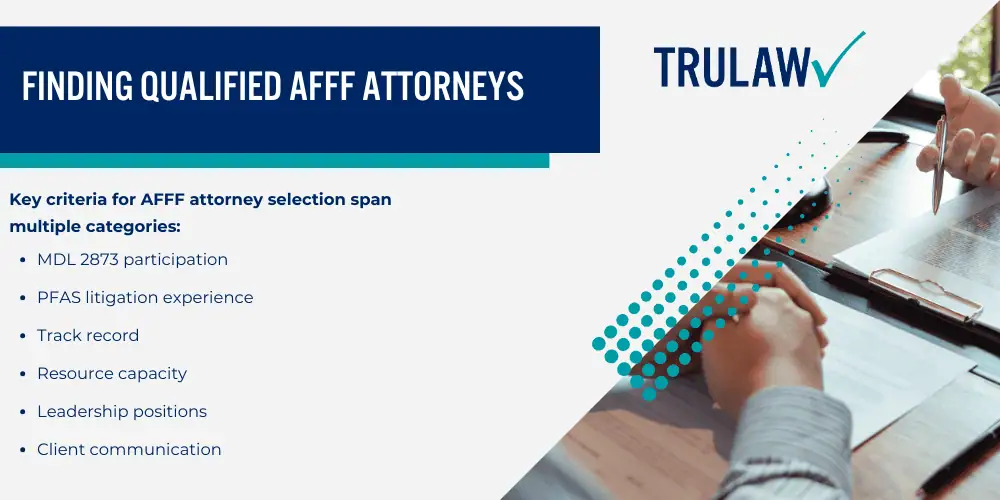
Key criteria for AFFF attorney selection span multiple categories:
- MDL 2873 participation: Active involvement in consolidated proceedings with established case load and court recognition
- PFAS litigation experience: Specific knowledge of firefighting foam cases rather than general personal injury practice
- Track record: Documented success in mass tort settlements and multi-district litigations against corporate defendants
- Resource capacity: Ability to fund expert witnesses, medical testimony, and case development costs through settlement
- Leadership positions: Appointment to Plaintiffs’ Steering Committee or liaison counsel roles indicating court confidence
- Client communication: Clear explanation of MDL process, realistic timeline expectations, and fee structures
Potential clients should specifically ask attorneys about their participation in the Plaintiffs’ Lead Counsel structure, number of AFFF cases currently handled, and relationships with toxicology experts who can strengthen individual causation arguments.
Avoid attorneys who promise specific settlement amounts or guaranteed outcomes, as ethical rules prohibit such representations.
The Legal Process From Filing to Settlement
AFFF litigation follows the established MDL framework beginning with individual complaint filing, automatic transfer to South Carolina federal court, and participation in consolidated discovery and settlement negotiations.
This streamlined process eliminates redundant litigation while preserving individual claim rights and allowing efficient resolution of common legal and factual issues.
The MDL litigation timeline includes, but is not limited to:
- Initial consultation: Attorney case evaluation, medical record review, and exposure documentation assessment
- Complaint filing: Individual lawsuit filing in appropriate federal district court based on plaintiff residence
- MDL transfer: Automatic case transfer to U.S. District Court for the District of South Carolina under Judge Richard Gergel
- Fact sheet completion: Standardized questionnaire detailing exposure history, medical conditions, and damages claims
- Discovery participation: Coordinated document production, depositions, and expert witness development
- Settlement negotiations: Global settlement discussions based on bellwether trial outcomes and aggregate case values
Most AFFF cases will resolve through global settlement without individual trials, typically requiring 18-36 months from filing to final payment distribution.
The October 2025 bellwether trial serves as an important milestone that typically accelerates settlement negotiations by establishing jury verdict ranges for similar cases.
Costs, Fees, and What to Expect
Reputable AFFF attorneys work exclusively on contingency fee arrangements ranging from 33-40% of recovery, with attorneys advancing all case expenses including medical records, expert witnesses, and court costs until successful settlement.
This structure ensures alignment between attorney and client interests while removing financial barriers for deserving plaintiffs.
Standard AFFF litigation costs and fee structures feature the following elements:
- Contingency fees: 33-40% of gross settlement or verdict amount with no payment unless successful recovery
- Case expenses: Attorney-funded costs for medical records, expert testimony, depositions, and filing fees
- No upfront payment: Free consultation and case development with costs recovered only from settlement proceeds
- Expense reimbursement: Client responsibility for advanced costs deducted from settlement before fee calculation
- Payment timeline: Settlement distribution typically occurs 60-90 days after global settlement approval
- Tax implications: Settlement proceeds may have tax consequences requiring consultation with qualified accountants
Settlement amounts are typically distributed through structured payment plans or lump sum options depending on case value and individual preferences.
Larger settlements exceeding $250,000 often benefit from structured arrangements providing tax advantages and guaranteed income streams, while smaller settlements generally involve immediate lump sum payments.
If you or a loved one are veterans and firefighters considering AFFF litigation, you may be eligible to seek compensation.
Contact TruLaw using the chat on this page to receive an instant case evaluation from attorneys experienced in MDL 2873 proceedings and learn how to join others in filing an AFFF lawsuit today.
Recent Developments and Future Outlook
The AFFF litigation has gained unprecedented momentum throughout 2025, with courts rejecting key defense arguments and new scientific research strengthening plaintiff causation claims.
The Environmental Protection Agency’s April 2024 drinking water standards for PFAS compounds provide regulatory validation of toxicity concerns, while the Department of Defense’s commitment to phase out AFFF by October 2025 acknowledges the health risks that manufacturers concealed for decades.
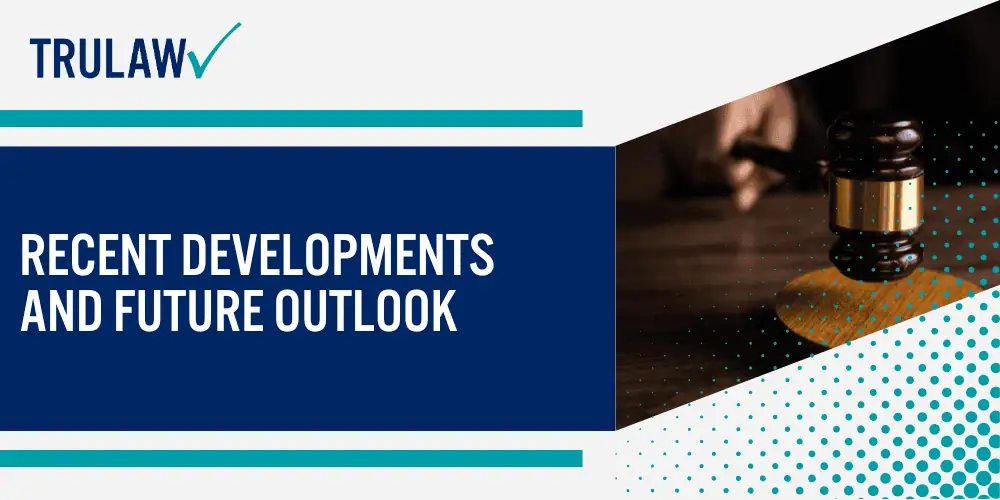
These converging developments have created optimal conditions for global settlement resolution, with legal experts predicting final agreements before year-end 2025 as defendant pressure intensifies from approaching bellwether trials and mounting litigation costs.
2025 Legal Victories and Momentum Shifts
Federal courts have consistently rejected defendant attempts to escape liability through procedural challenges, with judges dismissing government contractor immunity defenses and statute of limitations arguments that would have eliminated thousands of claims.
These rulings confirm that manufacturers cannot hide behind military contracts or claim protection from liability despite following government specifications for AFFF production and distribution.
Notable legal victories for plaintiffs in 2025 cover these achievements:
- Government contractor immunity rejection: Courts ruled that 3M and other manufacturers cannot claim immunity for AFFF-related injuries despite military contract compliance
- Statute of limitations expansion: Discovery rule applications allow claims filed years after diagnosis when PFAS-cancer links were not publicly known
- Causation standards established: Science Day presentations in June 2025 validated expert testimony linking PFAS exposure to specific cancer types
- Preemption defenses denied: Federal courts rejected arguments that EPA regulations preempt state law personal injury claims
- Class certification maintained: MDL consolidation preserved despite defendant challenges to common issues and damages calculations
- Settlement precedent established: Billion-dollar water contamination settlements demonstrate judicial approval of substantial PFAS liability
The momentum from these legal victories has shifted settlement negotiations decisively in favor of plaintiffs, with defense arguments increasingly unsuccessful and corporate defendants facing inevitable trial exposures that could result in punitive damage awards exceeding negotiated settlement amounts.
Scientific Studies Strengthening Plaintiff Cases
Recent research published in 2024-2025 has provided the strongest evidence to date connecting PFAS exposure to specific cancer types, with University of Michigan studies documenting altered gene expression in firefighters and National Cancer Institute research confirming elevated cancer rates among Air Force personnel.
This scientific consensus makes it increasingly difficult for defendants to dispute causation at trial.
Breakthrough research developments extend to these areas:
- Firefighter cancer mortality studies: Research confirming firefighters face notably higher cancer death rates compared to general population
- Biomarker identification: New laboratory methods detecting PFAS-induced cellular changes that precede cancer development
- Gene expression analysis: Studies showing how PFAS exposure alters DNA repair mechanisms and tumor suppressor genes
- Dose-response relationships: Quantified correlations between PFAS blood levels and cancer risk in exposed populations
- Mechanistic pathways: Research explaining biological processes by which PFAS chemicals trigger malignant transformation
- International consensus: Global health organizations recognizing PFAS as probable human carcinogens with sufficient evidence for causation
The EPA’s April 2024 national drinking water standards for PFAS compounds provide regulatory acknowledgment that these chemicals pose serious health risks at extremely low concentrations, supporting plaintiff arguments that any occupational exposure creates cancer risks requiring compensation.
Action Steps for Potential Plaintiffs
Veterans and firefighters who believe they qualify for AFFF compensation must act immediately to preserve their rights before global settlement registration deadlines exclude new participants from recovery opportunities.
The window for joining this litigation is rapidly closing as attorneys report imminent settlement negotiations that may conclude before October 2025 bellwether trials begin.
Immediate action items for potential plaintiffs highlight these priorities:
- Attorney consultation: Contact experienced AFFF attorneys within 30 days to preserve claim rights before settlement deadlines
- Document preservation: Gather military service records, employment histories, and medical documentation before records become unavailable
- Medical evaluation: Pursue comprehensive health screening to identify early-stage conditions that may qualify for compensation
- PFAS blood testing: Request serum concentration testing through VA or private laboratories to document exposure levels
- Timeline documentation: Create detailed exposure history including dates, locations, and duration of AFFF contact
- Family notification: Alert family members who may have secondary exposure claims through contaminated clothing or equipment
The unprecedented momentum in AFFF litigation, combined with defendant willingness to pay billions in settlements, creates a unique opportunity for deserving plaintiffs to obtain meaningful compensation for PFAS-related health impacts.
This opportunity will expire once global settlement terms are finalized and registration periods close permanently.
If you or a loved one are military veterans, firefighters, and others with AFFF exposure who risk exclusion from compensation, you may be eligible to seek compensation.
Contact TruLaw using the chat on this page to receive an instant case evaluation and ensure your AFFF lawsuit is filed before settlement negotiations conclude and eliminate future participation opportunities forever.
How Can an AFFF Firefighting Foam Attorney from TruLaw Help You?
Our AFFF firefighting foam attorney at TruLaw is dedicated to supporting clients through the process of filing an AFFF firefighting foam lawsuit.
With extensive experience in chemical-exposure litigation, Jessica Paluch-Hoerman and our partner law firms work with industry leaders to prove how toxic PFAS chemicals in AFFF firefighting foam—and the resulting contamination of water supplies—caused you harm.
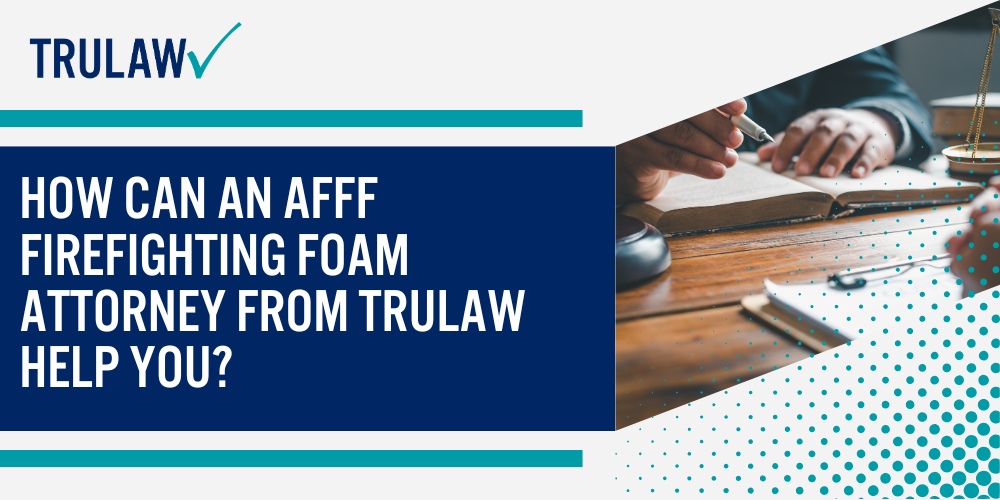
TruLaw focuses on securing compensation for medical expenses, pain and suffering, property damage, lost income, and ongoing health monitoring resulting from your AFFF exposure.
We understand the health and environmental impacts of AFFF firefighting foam on your life and provide the personalized guidance you need when seeking justice.
Meet the Lead AFFF Firefighting Foam Attorney at TruLaw
- Jessica Paluch-Hoerman: As founder and managing attorney of TruLaw, Jessica brings her product-liability and personal-injury experience to a client-centered approach that prioritizes open communication and personalized attention. Through TruLaw and its partner firms, she has helped recover more than $3 billion for injured individuals across all 50 states via verdicts and negotiated settlements.
How much does hiring an AFFF firefighting foam lawyer from TruLaw cost?
At TruLaw, we believe financial concerns should never stand in the way of justice.We operate on a contingency-fee basis—you pay legal fees only after you recover compensation.
If you or a loved one developed cancer or another serious illness after long-term exposure to AFFF firefighting foam (or PFAS-contaminated water linked to AFFF use), you may be eligible to seek compensation.
Contact TruLaw using the chat on this page to receive an instant case evaluation and determine whether you qualify to join others in filing an AFFF Firefighting Foam Lawsuit today.
TruLaw: Accepting Clients for the AFFF Lawsuit
AFFF lawsuits are being filed by firefighters, military veterans, airport personnel, and others nationwide after years of repeated exposure to toxic firefighting foam (AFFF) that contains per- and polyfluoroalkyl substances (PFAS).
TruLaw is currently accepting clients for the AFFF firefighting foam lawsuit.
A few reasons to choose TruLaw for your AFFF firefighting foam lawsuit include:
- If We Don’t Win, You Don’t Pay: The AFFF firefighting foam lawyers at TruLaw and our partner firms work on a contingency-fee basis— we only get paid if you win.
- Expertise: We have decades of experience handling toxic-exposure cases like the AFFF firefighting foam lawsuit.
- Successful Track Record: TruLaw and our partner firms have helped clients recover billions of dollars in compensation through verdicts and negotiated settlements.
If you or a loved one developed cancer or another serious illness after long-term exposure to AFFF firefighting foam, you may be eligible to seek compensation.
Contact TruLaw using the chat on this page to receive an instant case evaluation and learn whether you qualify for the AFFF Lawsuit today.
AFFF Lawsuit Frequently Asked Questions
-
What are the projected AFFF Lawsuit settlement amounts?
Attorney projections for AFFF lawsuit settlement amounts range from $20,000 for lower-tier cases to over $600,000 for severe cancer diagnoses (with most cases expected to fall between $250,000 and $450,000).
Settlement amounts depend on cancer type, exposure duration, age at diagnosis, and case strength.
Primary cancers like kidney and testicular cancer with extensive military or firefighting exposure will likely qualify for top-tier settlements exceeding $400,000, while secondary conditions and shorter exposure periods may receive lower-tier compensation.
These estimations are based on similar previous litigations, the nature of injuries sustained, and estimated costs of damages.
They are meant to provide a general idea of what settlement ranges could look like and should not be taken as definitive expectations for your case.
To obtain a more accurate understanding of the potential value of your case, it is best to consult directly with a qualified attorney who can provide personalized guidance.
You can do so by using the chat on this page to determine whether you qualify to join others in filing an AFFF lawsuit today.
-
When will AFFF lawsuits settle?
Legal experts predict AFFF personal injury settlements will conclude by end of 2025, driven by the October 6, 2025 bellwether trial deadline and over $11 billion already paid in other recent water contamination settlements.
The completion of municipal water settlements removed major obstacles to personal injury resolution, while approaching trial dates create pressure for defendants to negotiate global settlement terms.
Monthly case filings exceeding 400 new lawsuits indicate attorney confidence that settlement resolution is imminent within the next 6-12 months.
If you or a loved one are concerned about missing the settlement deadline and want to secure your place in the litigation, you may be eligible to seek compensation.
Contact TruLaw using the chat on this page to receive an instant case evaluation and determine whether you qualify to join others in filing an AFFF lawsuit today.
-
Which cancers qualify for AFFF lawsuits?
Primary qualifying cancers with strongest scientific support include kidney cancer, testicular cancer, liver cancer, thyroid cancer, and pancreatic cancer based on established PFAS causation evidence.
Secondary cancers and conditions that may qualify include prostate cancer, bladder cancer, breast cancer, ulcerative colitis, thyroid disease, and liver damage.
National Cancer Institute research specifically links PFAS exposure to kidney and testicular cancers in military personnel, while firefighter health studies show elevated rates across multiple cancer types requiring individual case evaluation.
If you or a loved one have been diagnosed with any of these cancers or health conditions after AFFF exposure, you may be eligible to seek compensation.
Contact TruLaw using the chat on this page to receive an instant case evaluation and determine whether you qualify to join others in filing an AFFF lawsuit today.
-
How long do I have to file an AFFF lawsuit?
State statutes of limitations vary from 2-6 years after cancer diagnosis, but discovery rules may extend deadlines when PFAS-cancer connections were not publicly known.
However, global settlement registration deadlines will supersede state law timing once settlement terms are announced, potentially creating 90-180 day windows for claim submission.
Veterans and firefighters should file immediately regardless of diagnosis date, as settlement participation requires active lawsuit filing before registration periods expire permanently and exclude late filers from compensation opportunities.
-
Do I need to pay upfront to hire an AFFF lawyer?
Reputable AFFF attorneys work exclusively on contingency fee arrangements of 33-40% with no upfront costs required from clients.
Attorneys advance all case expenses including medical records, expert witnesses, court costs, and filing fees until successful settlement recovery.
Clients pay nothing unless they receive compensation, with all advanced costs and attorney fees deducted from settlement proceeds.
Free consultations allow case evaluation without financial commitment, ensuring access to legal representation regardless of economic circumstances or ability to pay hourly legal fees.
If you or a loved one have been diagnosed with any of these cancers or health conditions after AFFF exposure, you may be eligible to seek compensation.
Contact TruLaw using the chat on this page to receive an instant case evaluation and determine whether you qualify to join others in filing an AFFF lawsuit today.
-
What evidence do I need for an AFFF lawsuit?
Medical documentation required to file an AFFF lawsuit includes military service records (DD-214 forms), employment histories proving firefighting duties, complete medical records confirming cancer diagnosis, and any available PFAS blood test results.
Additional helpful evidence includes water testing results, property records showing residence near contaminated sites, witness statements from colleagues, and documentation of exposure timeline and duration.
Experienced AFFF attorneys can help obtain missing records through military archives, VA databases, and Freedom of Information Act requests while working with medical experts to strengthen individual causation arguments
If you or a loved one have been diagnosed with any of these cancers or health conditions after AFFF exposure, you may be eligible to seek compensation.
Contact TruLaw using the chat on this page to receive an instant case evaluation and determine whether you qualify to join others in filing an AFFF lawsuit today.

Managing Attorney & Owner
With over 25 years of legal experience, Jessica Paluch-Hoerman is an Illinois lawyer, a CPA, and a mother of three. She spent the first decade of her career working as an international tax attorney at Deloitte.
In 2009, Jessie co-founded her own law firm with her husband – which has scaled to over 30 employees since its conception.
In 2016, Jessie founded TruLaw, which allows her to collaborate with attorneys and legal experts across the United States on a daily basis. This hypervaluable network of experts is what enables her to share the most reliable, accurate, and up-to-date legal information with our readers!
Additional AFFF Lawsuit resources on our website:
Here, at TruLaw, we’re committed to helping victims get the justice they deserve.
Alongside our partner law firms, we have successfully collected over $3 Billion in verdicts and settlements on behalf of injured individuals.
Would you like our help?
At TruLaw, we fiercely combat corporations that endanger individuals’ well-being. If you’ve suffered injuries and believe these well-funded entities should be held accountable, we’re here for you.
With TruLaw, you gain access to successful and seasoned lawyers who maximize your chances of success. Our lawyers invest in you—they do not receive a dime until your lawsuit reaches a successful resolution!
AFFF Lawsuit claims are being filed against manufacturers of aqueous film-forming foam (AFFF), commonly used in firefighting.
Claims allege that companies such as 3M, DuPont, and Tyco Fire Products failed to adequately warn users about the potential dangers of AFFF exposure — including increased risks of various cancers and diseases.
Depo Provera Lawsuit claims are being filed by individuals who allege they developed meningioma (a type of brain tumor) after receiving Depo-Provera birth control injections.
A 2024 study found that women using Depo-Provera for at least 1 year are five times more likely to develop meningioma brain tumors compared to those not using the drug.
Suboxone Tooth Decay Lawsuit claims are being filed against Indivior, the manufacturer of Suboxone, a medication used to treat opioid addiction.
Claims allege that Indivior failed to adequately warn users about the potential dangers of severe tooth decay and dental injuries associated with Suboxone’s sublingual film version.
Social Media Harm Lawsuits are being filed against social media companies for allegedly causing mental health issues in children and teens.
Claims allege that companies like Meta, Google, ByteDance, and Snap designed addictive platforms that led to anxiety, depression, and other mental health issues without adequately warning users or parents.
Transvaginal Mesh Lawsuits are being filed against manufacturers of transvaginal mesh products used to treat pelvic organ prolapse (POP) and stress urinary incontinence (SUI).
Claims allege that companies like Ethicon, C.R. Bard, and Boston Scientific failed to adequately warn about potential dangers — including erosion, pain, and infection.
Bair Hugger Warming Blanket Lawsuits involve claims against 3M — alleging their surgical warming blankets caused severe infections and complications (particularly in hip and knee replacement surgeries).
Plaintiffs claim 3M failed to warn about potential risks — despite knowing about increased risk of deep joint infections since 2011.
Baby Formula NEC Lawsuit claims are being filed against manufacturers of cow’s milk-based baby formula products.
Claims allege that companies like Abbott Laboratories (Similac) and Mead Johnson & Company (Enfamil) failed to warn about the increased risk of necrotizing enterocolitis (NEC) in premature infants.
Here, at TruLaw, we’re committed to helping victims get the justice they deserve.
Alongside our partner law firms, we have successfully collected over $3 Billion in verdicts and settlements on behalf of injured individuals.
Would you like our help?
